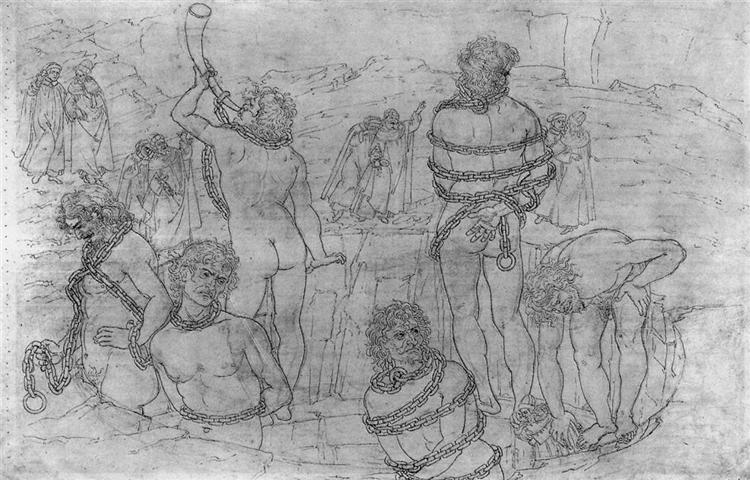Description
The painting "Inferno - Canto XXXI", made by Sandro Botticelli in 1480, is a work that deserves to be explored not only for its connection with the famous "Divine Comedy" by Dante Alighieri, but also for the technical mastery and emotional depth that characterize the work of the Florentine artist. In this representation, Botticelli delves into one of the darkest landscapes in literature, Hell, specifically in canto 31, where literary tradition meets the complexity of the visual world of the Renaissance.
The work, like many of Botticelli's, is notable for its rich composition and iconic use of line and colour. A chaotic and dynamic scene unfolds at the bottom of the painting, depicting a multitude of figures condemned to suffering. However, rather than brutal realism, as one might expect in a depiction of eternal pain, Botticelli opts for a compositional elegance, where the forms are arranged in an almost choreographic flow. This style reflects an intention of interpretation rather than simple representation, exploring the philosophical and moral implications of human suffering.
The colour palette used is remarkable, with earthy tones that evoke a hellish landscape predominating, while offering touches of blue and green that suggest the proximity of hope or spirituality, even in this place of perdition. This chromatic choice, which combines vibrant contrasts with more muted nuances, reveals Botticelli's ability to combine harmony and dissonance, leading the viewer to a deeper reflection on the subject matter.
As for the characters, the painting is populated by figures that, although anonymous, possess a powerful symbolic charge. The choice of interactions and postures reveals the desperation and internal struggle of each one, encapsulating a moment of intense emotional experience. A visual philosophy permeates the work: the notion of punishment not only as an end, but as an opportunity for reflection on past acts. This inclination to represent morality and the human condition in a more introspective way is characteristic of the late Renaissance, in contrast to the medieval tradition of a more dogmatic and punitive representation.
Botticelli's style, in its combination of idealization and realism, allows for interesting comparison with contemporary and later works in art history. Unlike his contemporaries who were more inclined toward precise anatomy and naturalism, Botticelli infuses an almost lyrical quality into his images. His technique, which emphasizes clear contour and form, suggests not only technical mastery but also a search for beauty in the tragic.
Similar paintings, such as The Birth of Venus or Primavera, reflect Botticelli's same fascination with the machinery of the human emotional universe, where the earthly and the divine coexist in a fragile balance. However, Inferno - Canto XXXI displays a restlessness about its subject matter that sets it apart, exploring not only the aspects of punishment, but also the duality of existence itself, which, between pleasure and pain, constantly chooses the path back.
Through a close examination of “Inferno – Canto XXXI,” not only Botticelli’s artistic mastery is revealed, but also his ability to induce the viewer to question issues of morality, spirituality, and the human condition as a whole. Just as the work is steeped in the literary tradition of Dante, it also establishes an ongoing dialogue with the eternal questions that humanity has faced throughout the centuries. This work stands as a testament to Botticelli’s creative genius and his unwavering desire to find meaning even in the darkest place of the collective imagination.
KUADROS ©, a famous painting on your wall.
Hand-made oil painting reproductions, with the quality of professional artists and the distinctive seal of KUADROS ©.
Painting reproduction service with satisfaction guarantee. If you are not completely satisfied with the replica of your painting, we will refund 100% of your money.

